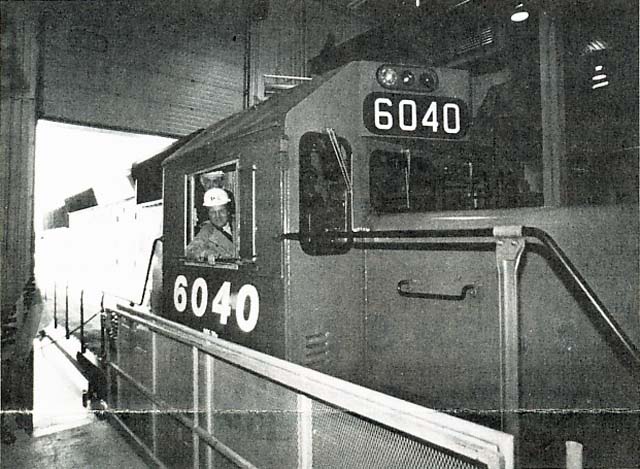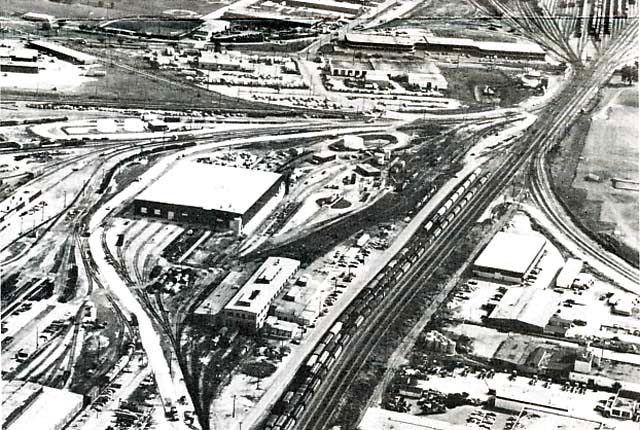|
|

Volume 13
Number 16
December 14, 1983
|
 |
|

Banner broken: CP Rail Executive Vice-President R.S. Allison looks over the shoulder of Transport Minister
Lloyd Axworthy as he guides an SD40-2 through a banner to open the Winnipeg Diesel Shop.
|
Innovative Shop Vital to Meet Traffic Growth
Winnipeg - One of CP Rail's biggest and newest diesel locomotives, a 3,000-horsepower SD40-2, drove through a banner at the new
Winnipeg Diesel Shop, 30 Nov 1983, signalling the official opening of the $16.5 million facility.
The new facility, west of McPhillips Street, will service and maintain a growing fleet of locomotives used to pull freight trains carrying grain, coal, potash,
sulphur, lumber, petrochemicals, and manufactured goods in Western Canada.
"The new diesel shop is vital to CP Rail's ability to maintain an ample supply of motive power for freight trains in the West as demand for transportation
grows during the 1980s", said Executive Vice-President R.S. Allison.
DOUBLING CAPACITY
The new diesel shop will make it possible to service and maintain 450 locomotives in Winnipeg, more than double the previous capacity of about 200 locomotives.
About 425 employees will be needed to maintain the locomotives when the new shop is working at capacity, compared with about 250 employees at present.
Just over half of the locomotives to be serviced here will be main line 3,000-horsepower SD40s, and the rest will be branch line 2,000-horsepower GP38s. Both
types are built by General Motors of Canada, Ltd.
This year, CP Rail spent $70 million to acquire 30 of the six-axle SD40-2s and 20 GP38-2s, smaller four-axle locomotives that are especially useful on
grain-dependent branch lines. The outlay was part of $700 million that CP Rail will spend over the next 10 years to enlarge its fleet capacity.
The new building is 320 feet (97.5 metres) long and 230 feet (70 metres) wide.
Virtually all of the pre-trip servicing and inspection will be performed indoors on two tracks going through the south side of the building.
This includes lubrication checks, inspection of wheel components, and other basic locomotive maintenance.
INNOVATIVE
In the north part of the building are four tracks, each equipped with platforms, pits, a lower working level, and a five-ton (4.5-metric-ton) overhead
travelling crane for crews performing repairs and working on the 45-day and 90-day preventative maintenance and inspections programs for diesel locomotives.
One of the innovations aimed at helping the maintenance staff work productively is a computerized ordering system capable of supplying material direct to a
work area by conveyer belt. A repairman needing a new part enters it on a video display terminal. The message is instantly transferred to the materials
department, from where the part is directed to the correct work area on the conveyer belt.
The old diesel shop building, with its 40-ton (36 metric ton) crane, will continue to be used for the heaviest repair jobs such as wheel and traction motor
changes and for yard engine repairs.
Most heavy repairs and all overhaul jobs will continue to be carried out in Calgary and Montreal and to a lesser extent at Weston Shops in Winnipeg.
To avoid having any exhaust fumes in the work area, the diesel engines will be started and all running tests performed outside at a diesel locomotive start-up
area a short distance from the east doors.
The only other outdoor work to be done is fuelling the locomotives and taking samples of lubricating oil for laboratory analysis. The laboratory can detect
trace metals in the lubricant. When trace-metal levels get beyond a threshold point, it is a symptom of serious engine trouble and prompts the job foreman to
call for a more detailed inspection of an engine.
A 90-foot (27.4-metre) turntable has replaced the turning loop track and is used to reverse the direction of diesels when necessary to meet operating
requirements.
|

From the air: CP Rail's new railway diesel shop, seen here, will enable the railway to service and maintain its
growing fleet of locomotives in Western Canada.
|
This CP Rail News article is copyright 1983 by the Canadian Pacific Railway and is
reprinted here with their permission. All photographs, logos, and trademarks are the property of the Canadian Pacific Railway Company. |


